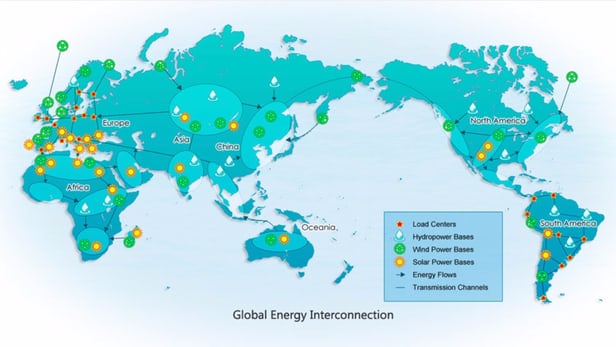GEIDCO wants to create an electric grid that connects all of Asia and then follow that with a grid that connects the entire world. GEIDCO – the Global Energy Interconnection Development and Co-operation Organization is a China-based group that now has agreements with energy companies in China, South Korea, Russia and Japan, as well as utilities, equipment manufacturers and universities from 14 countries.
The first step for GEIDCO is to build a connected Asia Super Grid that could bring the theoretically huge renewable energy generation capabilities of North China’s Gobi desert as far east as Japan.
The entire idea is contingent on ultra high voltage power transmission lines, thousands of miles operating at more than 1,000 kilovolts AC/800 kilovolts DC. High voltages reduce losses over long distances, and both Russia and Japan already have hundreds (in Russia’s case thousands) of miles of ultra high voltage lines up and running. These pale in comparison to China’s infrastructure; since 2009 China has built nearly 10,000 miles of UHV power lines, with about the same again to come online in the next two years.
The first step for GEIDCO is to build a connected Asia Super Grid that could bring the theoretically huge renewable energy generation capabilities of North China’s Gobi desert as far east as Japan.
The entire idea is contingent on ultra high voltage power transmission lines, thousands of miles operating at more than 1,000 kilovolts AC/800 kilovolts DC. High voltages reduce losses over long distances, and both Russia and Japan already have hundreds (in Russia’s case thousands) of miles of ultra high voltage lines up and running. These pale in comparison to China’s infrastructure; since 2009 China has built nearly 10,000 miles of UHV power lines, with about the same again to come online in the next two years.
China is investing RMB 600 Billion (approx. USD 88 Billion) into UHV development between 2010 and 2020
China proposed a $50+ trillion global grid
China was planning to transmit electricity from low cost coal
At higher voltages, eg 500kV and above, transmission losses over hundreds of kilometres are much reduced. At ultra-high voltages (UHV) eg 1000 kV AC or 800 kV DC, losses are further reduced (eg to 5% over 1000 km) but capital requirements are greater. In Germany consideration is being given to converting some existing AC lines to DC to increase their capacity. In the USA it is estimated that transmission losses amount to about 6%, or 250 TWh per year, worth some $20 billion. In India transmission losses in 2011 were 222 TWh (21%).
China is developing a very sophisticated grid system, since its main coal deposits are in the north, its main wind potential in the far west and its nuclear plants are on the coast – close to load centres. The grid system run by the State Grid Corporation of China (SGCC) and China Southern Power Grid Co (CSG) is growing rapidly, utilising ultra high voltage (1000 kV AC from 2009, and 800 kV DC from 2010) transmission. By 2015 SGCC invested CNY 500 billion ($75.5 billion) to extend the UHV grid to 40,000 km. By 2020, the capacity of the UHV network is expected to be some 300-400 GW, which will function as the backbone of the whole system, connecting six regional clusters. By 2020 there will be 400 GWe of clean energy sources connected, of which hydropower will account for 78 GWe, and wind power from the north a further significant portion. Wind capacity by 2020 is planned to be over 100 GWe. At the end of 2009, China had budgeted to spend $600 billion upgrading its grid. Over 2014 to 2020 high-voltage transmission lines are expected to increase from 1.15 million circuit km to 1.6 million circuit km, in line with a substantial increase in generation capacity, and operational transmission losses are expected to be 5.7%, down from 6.6% in 2010.
The USA has a patchwork of grids which are often barely interconnected. In 2012 a report from the American Society of Civil Engineers said that aging equipment and lack of capacity was leading to intermittent failures, and said that an extra $107 billion investment was needed by 2020.
By 2050, we need to accelerate the development of energy bases at the North Pole (wind power) and the Equatorial Regions (solar power), realizing intercontinental interconnections. By then the global energy interconnection will basically come into being.
The GEI initiative will require an unprecedented technology overhaul, including innovations in power, grid, and storage technologies.
State Grid has developed the necessary ultra-high voltage (UHV) grid technology to serve as a platform for extensive development, deployment and utilization of clean energy worldwide. State Grid has already built seven of its advanced power lines in China and has ten more under construction. Last year the company announced it was building an almost 1,300 mile long line in Brazil, connecting a hydroelectric dam on the Amazon River to cities in the southeastern part of the country.
According to estimates from State Grid’s research institute, it costs USD$0.08 per kilowatt-hour to generate and send wind power to China’s Xinjiang gird, and USD$0.04 to send it to Germany via UHV lines. The total cost of USD$0.12 is half that of clean power’s generation cost in Germany.

Brian Wang is a Futurist Thought Leader and a popular Science blogger with 1 million readers per month. His blog Nextbigfuture.com is ranked #1 Science News Blog. It covers many disruptive technology and trends including Space, Robotics, Artificial Intelligence, Medicine, Anti-aging Biotechnology, and Nanotechnology.
Known for identifying cutting edge technologies, he is currently a Co-Founder of a startup and fundraiser for high potential early-stage companies. He is the Head of Research for Allocations for deep technology investments and an Angel Investor at Space Angels.
A frequent speaker at corporations, he has been a TEDx speaker, a Singularity University speaker and guest at numerous interviews for radio and podcasts. He is open to public speaking and advising engagements.






